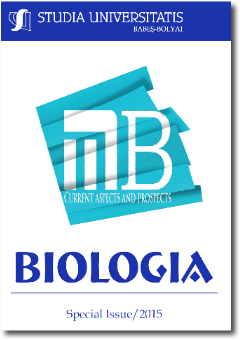New method for the molecular recognition of thyroid hormones
Keywords:
Enantiorecognition, inulins, stochastic microsensors, thyroid hormones.Abstract
The development of new methods that can detect a broad range of biomarkers became essential in modern medicine. The most frequent endocrine disorders include thyroid pathology. Stochastic sensors represent a unique class of single-molecule detectors and a promising candidate in biomedical analysis due to their ability to determine in one run more than one analyte. In clinical practice the main analytes used for the diagnosis and evolution of thyroid disease are free L-T3, L-T4 and TSH. A fast screening method based on stochastic sensors was proposed for the enantiorecognition of free L-T3, L-T4, D-T4 and TSH. Stochastic microsensors based on a mixture between two inulins (IN, TEX) and two ionic liquids (IN-L-Ala-C4-L-lac, IN-L-Phe-L-lac) immobilized on diamond paste (DP) were used for the assessment of thyroid hormones in whole blood samples. IN-L-Phe-C4-L-lac based microsensors showed the highest sensitivity for the assay of D-T4, L-T4 and TSH, while the highest sensitivity for L-T3 was obtained by using the stochastic microsensors based on IN-L-Ala-L-lac. The quantification limits obtained for thyroid hormones were: 10-12 mol/L for L-T4, 4x10-13 mol/L for L-T3, 6x10-12 for D-T4 mol/L and 5x10-15 g/mL for TSH.
The microsensors determined the thyroid hormones in whole blood samples with high reliability: recoveries higher than 95.00%, and RSD (%) lower than 1.00%. The microsensors had great features in biomedical analysis for pattern recognition of thyroid hormones. This will help early detection of related diseases.
References
Georgiou, S., Christofidis, I. (1996) Radioimmunoassay of free thyroxine (T4) using 125I-labeled T4-IgG complex with very large molecular weight, Clin. Chim. Acta., 244, 209-220
Gondová, T., Petrovaj, J., Sucha, M., Armstrong, D. W. (2011) Stereoselective HPLC determination of thyroxine enantiomers in pharmaceuticals, J.of Liquid Cromatogr. Rel. TechnoL., 34, 2304-2314
Jin, D., Zhang, M., Jin, S., Lee, M. K., Song, G. C., Back, G, Lee, Y. I. (2007) Enantioselective resolution of thyroxine hormone by high-performance liquid chromatography utilizing a highly fluorescent chiral tagging reagent, Chirality, 19, 625-31
Movileanu, L. (1990) Watching single proteins using engineered nanopores, Protein Pept. Lett., 21, 235-246
Sapin, R. M., d’Herbomez, M. (2003) Free thyroxine measurement by equilibrium dialysis and nine immunoassays in sera with various serum thyroxine-binding capacities, Clin. Chem., 49, 1531-1535
Stefan-van Staden, R. I., Balasoiu, S. C., Bazylak, G., van Staden, J. F., Aboul-Enein, H. Y., Radu, G. L. (2013) Inulins as electroactive materials for enantioanalysis of chiral drugs, J. Electrochem. Soc., 160, B192-B195
Wang, R., Jia, Z. P., Hu, X. L., Li, Y. M., Chen, L. R., (2003) Determination of serum thyroxine enantiomers in patients by liquid chromatography with a chiral mobile phase, J. Chromatogr. B. Analyt. Technol. Biomed. Life Sci., 785, 353-359
Wang, H. X., Wu, P., Dong, C., Wang, J., Wang, Y., Liu, J. C. (2014) Electrochemical biosensor based on interdigited electrodes for the determination of thyroid stimalting hormone, Int. J, Electrochem. Sci., 9, 12-21
Web sources
http://www.synevo.ro/ft4-tiroxina-libera/
http://www.synevo.ro/ft3-triiodotironina-libera/
http://www.abcam.com/thyroid-stimulating-hormone-tsh-human-elisa-kit-ab100660.html
Downloads
Published
How to Cite
Issue
Section
License
Copyright (c) 2015 Studia Universitatis Babeș-Bolyai Biologia

This work is licensed under a Creative Commons Attribution-NonCommercial-NoDerivatives 4.0 International License.





